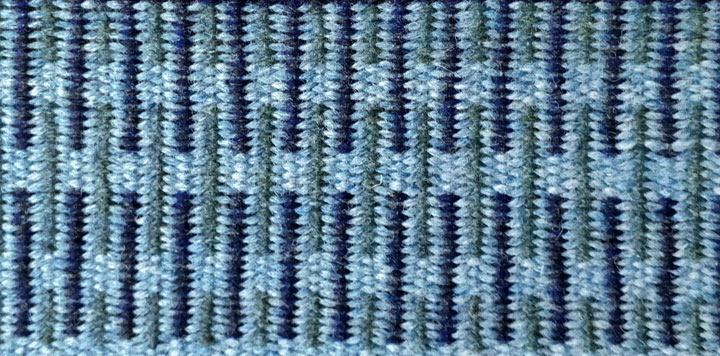I've finished the previous band from "Tablet Woven Treasures." and I'm pretty pleased with it. The orlec worked better than expected. It is quite fine and not as squishy as the mercerised cotton I usually like to use, but it created a nice vibrant band, so I'm glad I used it. I was so pleased, I even added the tassels as you can see in the picture. Okay - they aren't the world's best plaited tassels, but as I don't yet know what I'll use the band for I wasn't too fussed about them because chances are they're going to get cut off at some point in the future.
Once that band was off the loom I couldn't wait to warp up with the band I really wanted to make - band number 47. As with all the bands in the book the original was created at some point during the late Iron age. That apparently spans 800 to 1300AD (or 800 to 1300CE if you prefer).
The band caught my eye because the pattern reminded me of a double helix - like the structure of DNA. It was amazing to imagine someone coming up with the pattern all those centuries before the structure of DNA was discovered in the 1950s.
The band's turning pattern is much more complicated than the four forwards, four backwards pattern I'd been "warming up" with when making the blue band. With a mix of half turns and quarter turns which varied with each row I was worried I might lose my place and have to spend ages unravelling rows, so I created a map of the card turns and the resultant card positions. Goodness knows how those Iron age weavers kept track of the sequence.
The idea just came to me. If I knew where the cards were meant to be sitting I could check where any mistakes occurred. The diagram shows the idea. When row X is completed the letter marked on the card in the top position, nearest me is shown in the table. Above that is the next turning pattern and then the letters which will be top-nearest after that row, and so on. Obviously what's shown isn't the actual turning pattern - I don't want to infringe the copyright of the book author's by putting their designs out there without permission. They must have worked incredibly hard to take fragments of Iron Age textiles and turn them into the patterns in the book and I want to respect that.
The science bit
The discovery of the structure of DNA was made in 1953. At the time Francis Crick and James Watson were credited with the discovery but they owed much to the work of Rosalind Franklin and her co-researcher, Raymond Gosling.Franklin and Gosling's work on DNA and X-ray crystallography led to Gosling capturing the famous Photograph 51 (copyright Raymond Gosling/King's College London). The photograph, which revealed the double helix nature of DNA was shared with James Watson, without Franklin or Gosling's knowledge, and was instrumental in confirming the double helical structure that Crick and Watson went on to present.
I can still recall seeing a copy of photograph 51 durimg an A level physics lesson. It is a thing of beauty and science and it captured my interest and imagination then, as it does today. My woven band is frivolous compared with the work of Franklin et. al. but it thrills me to blend such an important scientific discovery into my textile work.
What inspires your work? Why not share it in a comment so others can be inspired.























